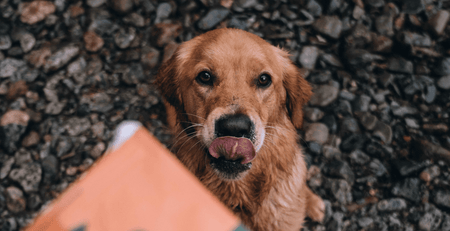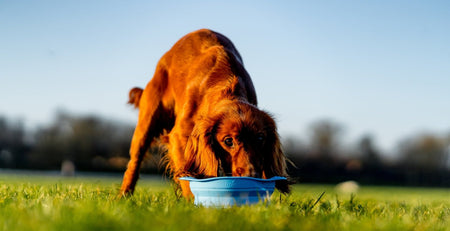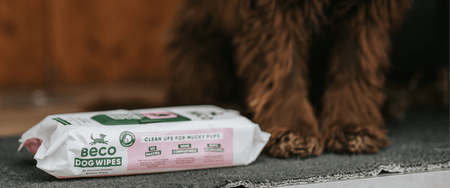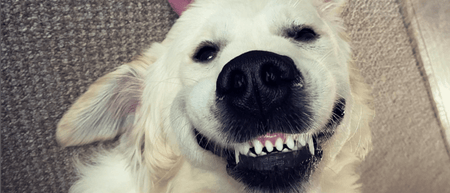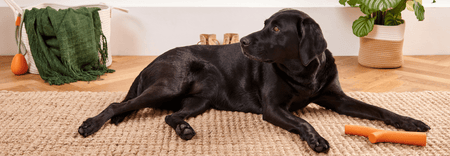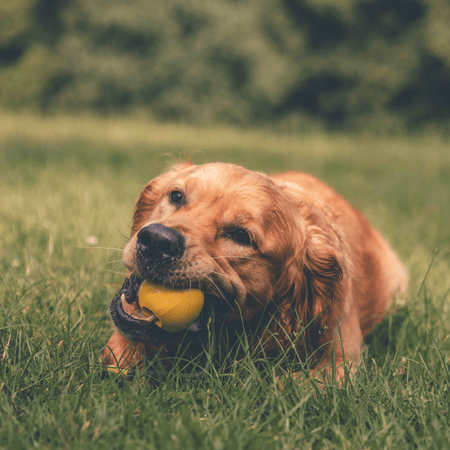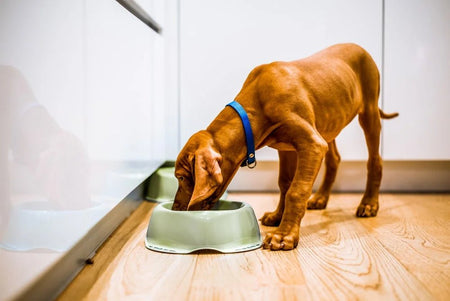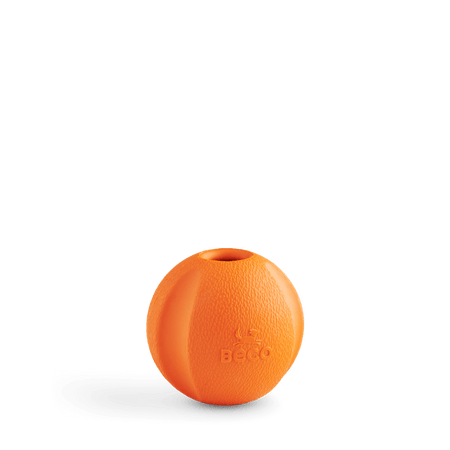Living with a hyperactive dog feels like hosting a furry tornado in your home. Every day brings new chaos - from shredded pillows to endless barking concerts.
Want to know how to calm a hyperactive dog? We've packed this guide with proven strategies that work.
No magic wands here - just expert advice and practical solutions to transform your energetic pup into a more peaceful companion.
- Provide interactive toys and engage in positive training exercises to help calm a hyperactive dog.
- Exercise needs vary dramatically by breed - working dogs need 2+ hours while toy breeds thrive on 30-60 minutes.
- Strategic environment design and consistent routines slash hyperactive behaviour by setting clear boundaries.
Why Is My Dog So Hyper?
Dogs get hyper for various reasons. Breed characteristics, lack of exercise, and their surroundings all play a part.
Here are some common signs that your dog in hyperactive:
-
Leash pulling
-
Jumping
-
Restlessness
-
Tail chasing
-
Counter hopping
-
Constant barking
-
Destructive play
-
Rummaging
How To Calm A Hyperactive Dog
Exercise: The Key to Calmness
Dogs need between 30 minutes to 2 hours of daily exercise, depending on their breed and age.
A tired dog naturally becomes a calmer dog. Try one or two of these exercise strategies to burn off your pup’s excess energy:
1. Morning Jog Sessions (30-45 minutes)
Start your day with a jog. Switch between walking and running to build stamina for both you and your pup.
Use natural obstacles like logs or curbs for extra coordination practice. Add in quick sprint bursts to release pent-up energy, and end with a cool-down walk to signal calm time.
Keep your pup engaged and focused on you by changing directions randomly to engage their brain.
2. Structured Play Time
Keep play sessions fun but focused. Try:
-
Fetch with varying distances and heights
-
Rules-based tug-of-war with clear start/stop signals
-
Garden agility courses using household items
-
Ball games with obedience commands mixed in
-
Frisbee sessions with rest breaks
Daily Exercise by Breed Type
Just like people, no two dogs are alike, and how much exercise your pup needs depends on their age and breed type.
While sheepdogs may need at least two hours of exercise a day to keep them calm, miniature breeds and senior dogs could be content with just half an hour of play.
| Type | Suggested Time | Best Activities |
|---|---|---|
| Working Dogs | 2+ hours | Running, agility, herding games |
| Sporting Dogs | 1-2 hours | Swimming, retrieving, tracking |
| Toy Breeds | 30-60 mins | Short walks, indoor games |
| Senior Dogs | 30-45 mins | Gentle walks, nose work |
Mental Stimulation: The Game Changer
Mental exercise tires dogs faster than physical activity alone.
UK-based veterinary experts recommend providing interactive toys and engaging in positive training exercises to help calm a hyperactive dog.
Here are a few brain-draining activity ideas:
1. Food puzzles
Keep your pup sharp by giving them food puzzles that start simply and get more difficult as they figure things out.
2. Scent Trails
Use your pup’s favourite treat or toy to create a fun sniffing adventure. Simply hide them along a scent trail for your dog to follow.
3. Training Sessions
Upskill your pup by teaching them new tricks or commands. This keeps them busy and is an enjoyable learning experience for both you and your furry friend.
4. Hide and Seek
Get the family together and play hide and seek with your dog. The kids will love it and your pup uses its nose and brain to find you.
5. Obstacle Courses
Challenge your pup mentally and physically by setting up a mini obstacle course. Not only does your dog get a workout, but they also get to put their thinking caps on.
6. Command Chains
Challenge your dog by linking together multiple commands they have to follow in order. Build complexity gradually to keep your pup’s attention.:
7. Interactive Toys
Use interactive toys that make your dog think to get to the reward inside. Your pup uses their problem-solving skills and gets a delicious treat as a reward.
As a bonus, interactive toys don’t need your constant intervention, so you can leave your pup to mentally stimulate themselves.
Treat-dispensing balls are another great idea. They make your dog work and think before they get their snack.
Create a Calming Environment
If you want to calm a hyper dog naturally, you need to set up the right environment. This plays a huge role in maintaining calm behaviour throughout the day.
Here’s how to do it:
1.Set Up Designated Zones
There are various options. Pick one or two that most suits your lifestyle:
-
Quiet corners with comfortable beds, cuddle toys and blankets
-
Play areas with clear boundaries
-
Training spaces away from distractions
-
Chill-out spots with calming views
-
Safe spaces for overwhelming moments
2. Sensory Management
Don’t let your pup’s senses become overwhelmed. Try a few of these ideas:
-
Reduce external noise with sound barriers
-
Control lighting with dimmer switches
-
Maintain comfortable temperature year-round
-
Use calming scents like lavender
-
Install window films to reduce street distractions
Nighttime Solutions
Calming a hyperactive dog at night becomes easier with routine. Creating a solid evening schedule helps your pup wind down naturally.
Evening Exercise
Keep your dog happy and relaxed before bedtime with evening exercise.
Follow that with a play session that’s more about thinking than running — puzzle toys, scent games, or interactive challenges.
As bedtime gets closer, help them recognize that it's time to calm down by using consistent cues, like a specific word or phrase paired with a soothing voice.
Bedtime Rituals
Dogs thrive on routine, so offer them a consistent bedtime to get them settled for the night. Start with quiet-time activities like gentle brushing or a relaxing cuddle session.
Preparing their sleeping area with a comfy bed or blanket. A brief calming massage can work wonders for reducing restlessness, making it easier for them to drift off.
For added relaxation, play soft music or use white noise. Keep the room dark to signal it’s time to sleep.
Diet and Behaviour Link
Diet impacts your pup’s behaviour. Keep them calmer with high-quality, nutritionally balanced food.
-
Smaller, frequent meals
-
High-quality proteins for sustained energy
-
No artificial additives that spike energy
-
Enough water
Frequently Asked Questions
How do you calm an overstimulated dog?
Remove your pup from exciting situations, provide a quiet space, and offer calming activities like licking mats or chew toys.
How do you discipline a hyper dog?
Skip punishment - it increases anxiety and hyperactivity. Instead, redirect energy to appropriate activities and reward calm behaviour.
Why is my dog so hyper?
Common causes include insufficient exercise (40% of cases), breed traits (30%), and environmental factors (20%).
Conclusion
From morning jogs to evening wind-down routines, calming a hyperactive dog takes a mix of physical exercise, mental challenges, and smart environmental tweaks.
The key? Building routines that match your dog's energy levels and natural instincts. Each small step adds up - whether it's introducing food puzzles or creating cosy chill zones.
Need help setting your pup up for success? Our range of calming toys, interactive puzzles, and nutritious treats gives you the tools to build a more peaceful relationship with your four-legged friend. Shop our collection and start your journey toward a calmer, happier pup today.

